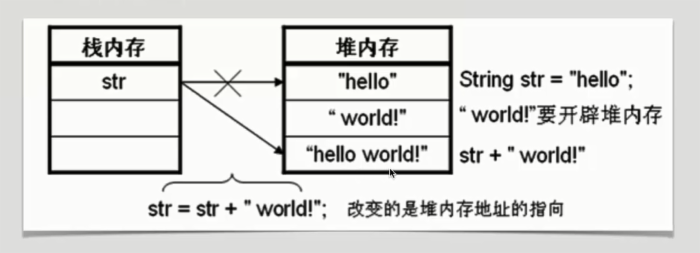浅谈javascript和java中的字符串
作者:网络转载 发布时间:[ 2015/5/29 14:17:04 ] 推荐标签:Java
java字符串操作
一、字符串的创建
1、直接赋值 String str=”hello“;//这里必须要双引号
2、使用new关键字 String str=new String("hello")
两种创建方式的异同:

结论:采用第二种方式创建字符串时:系统会在堆内存中创建两个”hello“,但是其中一个”hello“没有的对应的栈内存指引,消耗多余内存,垃圾空间等待被回收。
所以推荐使用第一种方式创建字符串
二、字符串的常用方法
java的很多字符串方法的名字和用法都和js字符串方法类似。
1、public char charAt(int index) 返回指定索引处的 char 值
2、public String concat(String str) 将指定字符串连接到此字符串的结尾。
3、public int indexOf(String str,int fromIndex) 返回指定子字符串在此字符串中第一次出现处的索引,
。。。。
我觉得应该注意的几个好玩方法:
1、public int length() 返回此字符串的长度 这里和js有着细微的区别
2、public boolean startsWith(String prefix, int toffset) 测试此字符串从指定索引开始的子字符串是否以指定前缀开始。
3、public boolean endsWith(String suffix) 测试此字符串是否以指定的后缀结束。
4、public char[] toCharArray() 将此字符串转换为一个新的字符数组。
5、public void getChars(int srcBegin, int srcEnd,char[] dst,int dstBegin) 将字符从此字符串复制到目标字符数组。
三、字符串打的不可变性

看图可以,不多解释
四、”另类字符串“
1、StringBuffer sb=new StringBuffer("df");//长度可变,
常用方法:
append()
insert()
replace()
indexOf()
2、StringBuilder sb =new StringBuilder("dsf")
特别适用在单个线程 速度比StringBuffer快
考虑线程安全时,用Stringbuffer比较好
相关推荐

更新发布
功能测试和接口测试的区别
2023/3/23 14:23:39如何写好测试用例文档
2023/3/22 16:17:39常用的选择回归测试的方式有哪些?
2022/6/14 16:14:27测试流程中需要重点把关几个过程?
2021/10/18 15:37:44性能测试的七种方法
2021/9/17 15:19:29全链路压测优化思路
2021/9/14 15:42:25性能测试流程浅谈
2021/5/28 17:25:47常见的APP性能测试指标
2021/5/8 17:01:11













 sales@spasvo.com
sales@spasvo.com